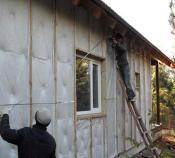Search
Login
Recommended
Mulching the soil, what it is, useful tips
Experienced growers and gardeners do not need to prove the usefulness of such an event as mulching for a long time. It is not at all difficult to imagine that mulch is about the same as a blanket for a resting person - in any weather and at any temperature you feel more comfortable under it. Mulching is used on different soils and in different climatic zones, the process consists in sheltering the surface of the earth in the beds with the help of artificial or natural materials. The entire area of \u200b\u200bthe beds or only the row spacing can be mulched.
Content:
- What is mulching video
- Use for mulching artificial cover materials
- Types of Organic Mulch and its Proper Use video
- Is it necessary to mulch the soil in the greenhouse
What is mulching the soil
Mulching is by no means an invention of agronomists; people made conclusions about its necessity and effectiveness by observing natural nature. Indeed, in the forest or in the meadow, under bushes, trees or grass, you can never see open ground - there is always a layer of leaves, needles, dried grass on it.

Such a shelter is a reliable protection that can prevent the soil from drying out, cracking it, and supercooling the roots during severe frosts in snowless winters. Under the mulch, the formation of soil crust does not occur, and during heavy rain the earth is not eroded and the roots are not exposed. Naturally, the shelter does not allow sunlight to directly affect the soil and accelerate the evaporation of moisture, it also creates an obstacle to the growth of weeds.
Using mulching of beds it is possible to significantly reduce the number of irrigation, frequent loosening of the soil can also be abandoned.
Since the usefulness of the procedure is beyond doubt, it makes sense to consider how to mulch the soil and what materials are best used. It should be noted that there are many options, everyone can find an economically feasible solution, which is also easy to translate into reality on their own.

You can learn more about mulching when watching a video:
Use for mulching artificial cover materials
The material for mulching the soil can be natural or have artificial origin.
Gardeners recognize that it is convenient to use:
- roofing period or only
- plastic films, black or multi-colored,
- lutrasil.

When using these covering materials, the following technology is applied:
the canvas is spread on the beds, the points of teething are marked out,
seedlings are planted in the prepared holes.
A little trick - longitudinal or transverse slots, unlike round or oval, will more protect the soil from moisture evaporation, while they will not create an obstacle to the penetration of rainwater.
To mulch the beds of cucumbers or zucchini, you can use a black film. The same is used to mulch strawberry plantations - the berries will not have contact with the ground and will be clean.

Interestingly, for beds with tomatoes it is better to use an opaque film of red color, and for cabbage - white. Red color provokes accelerated ripening of the tomato, and white color prevents excessive heating of the soil, the temperature regime is important for the growth of cabbage.
The use of a transparent film is not recommended - penetrating sunlight and high humidity will provoke active growth of weeds.
Therefore, the film for mulching should be selected taking into account the following criteria:
- light tightness
- ability to fit snugly to the ground, i.e. elasticity,
- proper strength.
Using a film for mulching will increase the temperature of the soil by about two degrees, which is quite important in the conditions of a short summer in the northern regions, and will also make the daily temperature difference softer. On hot days, on the contrary, the film will help lower the temperature.
Thus the film:
- will organize the protection of plants from excessive cold and heat,
- save plants from drought,
- save your time on loosening the soil,
- will save money on the purchase of chemicals for the destruction of weeds, in particular sow thistle, loach, wheatgrass,
- will provide the roots with enough oxygen,
- prevents soil compaction from precipitation, for example, after growing strawberries in the area under the film for several years, the soil will remain loose,
- on strawberries and strawberries, the development of gray rot practically ceases.
Film mulching can also increase soil fertility:
- under it, seedlings of weeds rot, enriching the soil with nitrogen,
- beneficial microorganisms under reliable cover of the film develop more actively,
- the percentage of humus in the soil rises.

The film-mulch with the onset of frost creates protection for the earth, which in turn prevents freezing of the roots of plants, this moment is especially important for dwarf apple trees and strawberries, which are not particularly frost-resistant.
The disadvantage of artificial covering material is its non-decomposition tendency and inability to provide additional soil nutrition. Therefore, gardeners wise by experience prefer to lay on the ground mulch of natural origin, for example, humus, and then cover it with a film or non-woven cloth.
Types of Organic Mulch and its Proper Use
In choosing a covering material, summer residents often prefer natural ones, which are capable of:
- inhibit the growth of weeds,
- decompose, enrich the fertile soil layer,
- keep moisture in the ground,
- protect the roots from freezing or overheating.

But to obtain the desired effects, you will need to know how to apply this or that type of mulch.
Watch a video about mulching materials:
grass mulching
You can get material for mulching when mowing lawns or mowing wild herbs, removing weeds, and pinching tomatoes. Precisely ragged stepsons should be used to mulch cabbage - a pungent smell will scare away the cabbage pest - the whitewash.

It is not recommended to use freshly cut herbs, it is advisable to dry them a little in the sun, as Fresh grass is more prone to decay.
If you can mulch the beds in the southern regions even before planting, in the northern areas, well-heated soil is covered with grass, in which the plants have already sprouted and matured.
More detailed recommendations on the video:
how effective is compost mulch

Compost in all respects is an ideal covering material, suitable and safe for all vegetable crops. Compost provides some protection of plants from diseases and provides them with high-quality top dressing.

In addition, laying compost heaps of leaves, leaves, shavings and paper, all kinds of organic waste can solve the problem of waste disposal. You can get high-quality compost in just one year, with the correct laying of the compost heap.
in which case it is rational to use straw
It is best to use straw to cover the ground under potatoes and tomatoes.

Its thick layer will create a reliable barrier between pathogenic fungi located in the soil and leaves of plants, this will prevent the development of leaf spotting, anthracnose and early rot. Straw will also prevent the massive defeat of potatoes by Colorado potato beetles. Straw has a beneficial effect on garlic, strawberries and blackberries.
mulch from tree bark and other woodworking waste
Since wood bark is a waste of the wood industry, it is not difficult to get it. This is one of the materials that allows long-term use - the bark is able to repel water, so the decomposition process in it is very slow. Using bark is beneficial if necessary to mulch the earth around shrubs and trees.

If the bark is obtained from conifers, then it is not recommended to use it on tomato beds, the release of fragrant volatile substances will be harmful to tomatoes.
Among other advantages, the bark mulch has a rather decorative appearance, it can be used as a decoration for flower beds - it is both beautiful and useful for plants. In modern design, crushed bark is often used as a decoration material.

Other waste from wood processing enterprises - sawdust and wood chips - is no less in demand. Mulching the soil with sawdust is rational if this area of \u200b\u200bthe soil is not dug up and is rarely subjected to cultivation. The fact is that rotting chips usually lasts for a couple of years.
Mulching with wood chips of raspberry beds, areas with garlic or tulips planted for the winter is often used.
Mulching strawberries with sawdust gives an excellent result, but in no case should you use caked material. In any case, such sawdust before use will need to be spread with a thin layer and dried well.

It is used to mulch even needles, mainly on strawberry beds and eggplant plantations.

Sometimes gardeners refuse to use needles, fearing that it causes an increase in the acidity of the soil. Nevertheless, in practice it is proved that mulching needles for two years did not lead to a change in acidity.
how to use fallen leaves
They are also a good mulching material, they can be used on cabbage or bean beds. The leaves are used in the cultivation of crops such as peppers, eggplant, tomatoes, but you can stack the mulch if the mail is sufficiently warm.
Deciduous mulch is an ideal material for laying on flower beds:
- during severe frosts, it will reliably protect the roots,
- during the first spring thaws, bulbous plants do not have time to germinate, this will save them from frostbite.

Experienced gardeners recommend the use of combined materials, for example a mixture of:
- reeds and humus,
- peat chips and waste obtained during the cleaning of pumpkin or sunflower seeds,
- cardboard and freshly cut grass,
- straw and wrapping paper,
- sawdust with fresh grass.
The mulch laying layer can be from 3 to 10 cm.
paper mulching features
Newspapers, cardboard or Kraft packaging paper can be used in sheets or in crushed form, but the paper layer should have an appropriate thickness, at least - corresponding to a four-fold newspaper sheet. Such a shelter can provide protection against sprouting weeds; to increase efficiency, a layer of paper is covered with straw or hay; you can also cover it with earth.

There is an opinion that printing ink can be harmful, but scientists have proved that none of the components of the ink used in modern printing houses can do any harm to the garden or kitchen garden.
The use of sheets of cardboard or kraft paper instead of plastic film will increase the temperature of the soil in a couple of days by 2-3 degrees. This fact is very important in the process of preparing the soil for planting seedlings.
It is noted that mulching paper with beds of legumes and raspberries has a significant effect on increasing yields.
Is it necessary to mulch the soil in the greenhouse

Modern agronomy recognizes that mulching the soil in greenhouses gives a positive result, in particular:
- reduces the amount of water used for irrigation and reduces the amount of irrigation itself,
- eliminates weeding and maintains a satisfactory soil permeability,
- helps get rid of weeds,
- reduces the risk of diseases of cucumbers and tomatoes,
- makes the soil temperature more stable with noticeable changes in air temperature.

The same natural materials that are used for open ground can be used as mulch in greenhouses, the laid layer should have a thickness of at least 5 - 8 cm. It is recommended to leave a small free space around the stem itself - it will be easier to water the plants.





